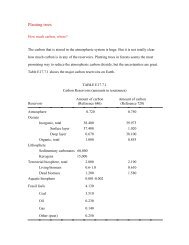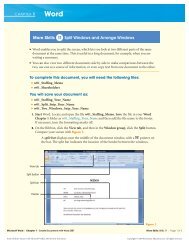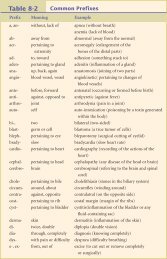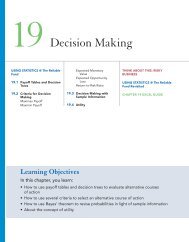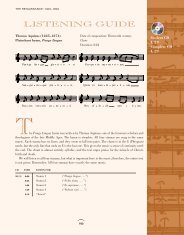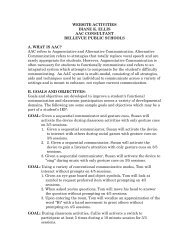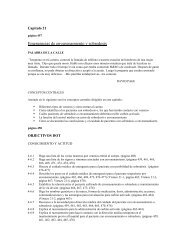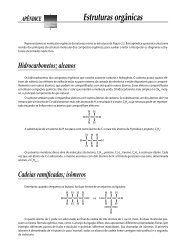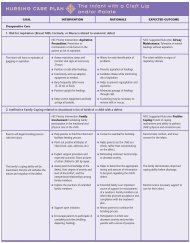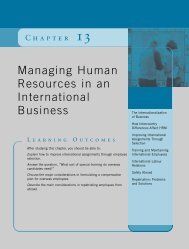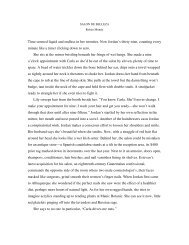chapter
chapter
chapter
Create successful ePaper yourself
Turn your PDF publications into a flip-book with our unique Google optimized e-Paper software.
210 Unit Three Forces Within<br />
nental lithosphere, continued subduction eventually<br />
brings the two continents together (Figure 7.12C).<br />
Whereas oceanic lithosphere is relatively dense and<br />
sinks into the asthenosphere, continental lithosphere is<br />
buoyant, which prevents it from being subducted to any<br />
great depth. The result is a collision between the two<br />
continental blocks (Figure 7.14).<br />
Such a collision occurred when the subcontinent of<br />
India rammed into Asia and produced the Himalayas—<br />
the most spectacular mountain range on Earth (Figure<br />
7.14). During this collision, the continental crust<br />
buckled, fractured, and was generally shortened and<br />
thickened. In addition to the Himalayas, several other<br />
major mountain systems, including the Alps, Appalachians,<br />
and Urals, formed during continental collisions.<br />
Prior to a continental collision, the landmasses involved<br />
are separated by an ocean basin. As the continental<br />
blocks converge, the intervening seafloor is<br />
subducted beneath one of the plates. Subduction initiates<br />
partial melting in the overlying mantle rocks, which<br />
in turn results in the growth of a volcanic arc. Depending<br />
on the location of the subduction zone, the volcanic<br />
arc could develop on either of the converging landmasses,<br />
or if the subduction zone developed several<br />
hundred kilometers seaward from the coast, a volcanic<br />
island arc would form. Eventually, as the intervening<br />
seafloor is consumed, these continental masses collide.<br />
This folds and deforms the accumulation of sediments<br />
along the continental margin as if they were placed in<br />
a gigantic vise. The result is the formation of a new<br />
mountain range, composed of deformed and metamorphosed<br />
sedimentary rocks, fragments of the volcanic<br />
arc, and possibly slivers of oceanic crust.<br />
After continents collide, the subducted oceanic plate<br />
may separate from the continental block and continue<br />
its downward movement. However, because of its<br />
buoyancy, continental lithosphere cannot be carried<br />
very far into the mantle. In the case of the Himalayas,<br />
the leading edge of the Indian plate was forced partial-<br />
Figure 7.15 Diagram illustrating a<br />
transform fault boundary offsetting<br />
segments of a divergent boundary<br />
(oceanic ridge).<br />
Inactive<br />
zone<br />
ly under Asia, generating an unusually great thickness<br />
of continental lithosphere. This accumulation accounts,<br />
in part, for the high elevation of the Himalayas and may<br />
help explain the elevated Tibetan Plateau to the north.<br />
Transform Fault Boundaries<br />
EA R T H S C I E N C E<br />
Forces Within<br />
Plate Tectonics<br />
The third type of plate boundary is the transform fault,<br />
where plates grind past one another without the production<br />
or destruction of lithosphere. Transform faults<br />
were first identified where they join offset segments of an<br />
ocean ridge. At first it was erroneously assumed that the<br />
ridge system originally formed a long and continuous<br />
chain that was later offset by horizontal displacement<br />
along these large faults. However, the displacement<br />
along these faults was found to be in the exact opposite<br />
direction required to produce the offset ridge segments.<br />
The true nature of transform faults was discovered<br />
in 1965 by a Canadian researcher who suggested that<br />
these large faults connect the global active belts (convergent<br />
boundaries, divergent boundaries, and other<br />
transform faults) into a continuous network that divides<br />
Earth’s outer shell into several rigid plates. Thus, he became<br />
the first to suggest that Earth was made of individual<br />
plates, while at the same time identifying the<br />
faults along which relative motion between the plates is<br />
made possible.<br />
Most transform faults join two segments of a midocean<br />
ridge (Figure 7.15). Here, they are part of prominent<br />
linear breaks in the oceanic crust known as fracture<br />
zones that include both the transform fault as well as their<br />
inactive extension into the plate interior. These fracture<br />
zones are present approximately every 100 kilometers<br />
along the trend of a ridge axis. As shown in Figure 7.15,<br />
active transform faults lie only between the two offset<br />
Fracture zone<br />
Transform fault<br />
(active)<br />
Inactive<br />
zone




